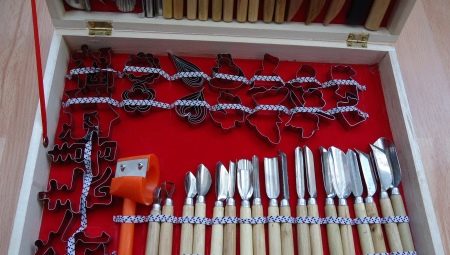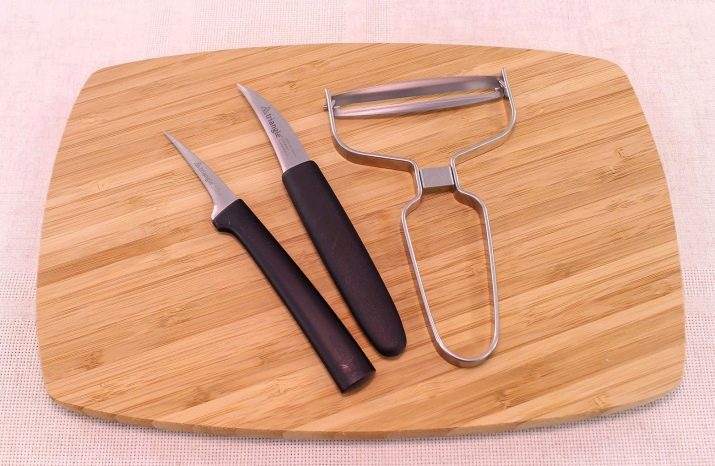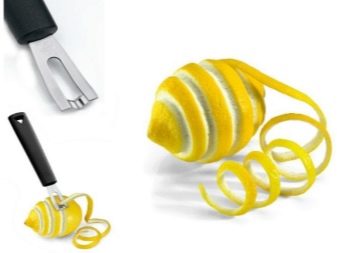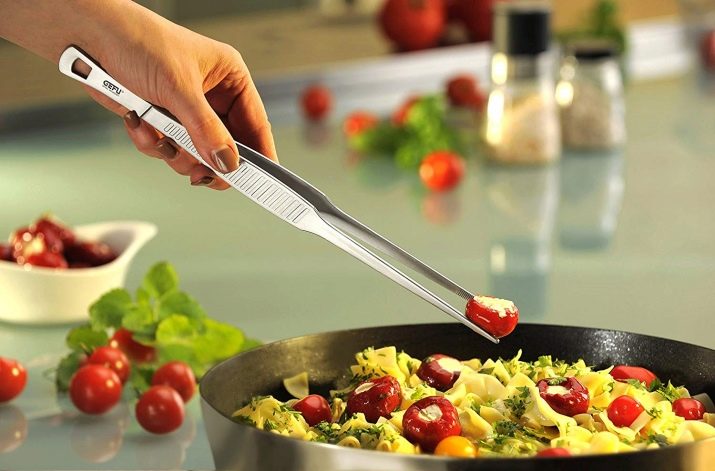Carving knives: types, selection and rules of use

Carving (artistic cutting of vegetables and fruits) is becoming more and more popular. After all, this is not only an interesting and creative hobby, but also a way to decorate the table with beautiful compositions. Therefore, it is worth considering the common types of carving knives, the features of their choice and the basic rules of use.



Why do you need special tools?
To get acquainted with the art of carving and the first lessons in it, a universal kitchen knife will be enough. However, in order to apply thin patterns to the surface of fruits and vegetables, cut out spirals, garlands and other curly elements from them, make curly holes in them and make grooves and slices of equal thickness, you will need specialized kits.

Varieties
Currently, the main types of tools for decorative cutting for vegetables and fruits are as follows.
- Thai knife - This tool has a thin and narrow sharpened blade with a short length relative to the handle and low weight. There are two subtypes of these products - with a straight blade and a sickle blade. In most cases, they have an even blade, but there are options with small teeth for working with soft foods (such as tomatoes).
With the help of such products, you can cut out almost any elements of the composition, but the main purpose of the knives is to make unique small details. It is this tool that will give your work a personality.

- Carb knives - the name of these products comes from the German word "kerben", which means "cut, make grooves".The main task of the tool is to create grooves. The shape of the holes made with it depends on the shape of the blade.
Currently, the most common carbide knives with blades of square, oval, round, V-shaped, triangular, semicircular and curly profile. Sometimes there are ribbed options that allow you to make grooves of complex shapes.


- Engraving knives - at first glance, they have little resemblance to knives, since they represent a closed cutting edge of a complex profile on the handle. They are used to apply repeating grooves and linear patterns to the surface of vegetables and fruits.

- Noisettes - These original knife / spoon hybrids allow you to quickly and easily cut spherical and hemispherical elements of your composition. In addition, with their help, it is convenient to extract pulp and seeds from fruits.

- Flute tools - will allow you to cover the surface of food with even grooves, as well as cut them into strips or thin strips.


- Grooved sizing knives - have the shape of a corrugated ridge and allow you to cut slices of products with wavy edges.

- Serpentine cutters - are used for beautiful cutting of fruits and vegetables in the form of a serpentine, usually arranged according to the principle of a pencil sharpener. The tool is like a funnel with blades inside.

- Spiral knives - a variation of the serpentine cut, which allows you to cut food in a thin spiral or zigzag. Outwardly they look like an hourglass or funnel.

- Screw knives - are used to remove pulp and create elements in the form of flowers.

- Peel knives - allow you to properly remove the zest of citrus fruits.

- Curlers - this device allows you to quickly and easily cut garlands of hard and oblong vegetables such as cucumbers, zucchini and carrots.

Optional equipment
In addition to knives, other kitchen tools are often used for carving:
- peeler - allows you not only to quickly peel off fruits and vegetables, but also to cut them figuratively;

- scissors - used to decorate thin edges (for example, if you want to make a composition in the form of a flower);

- cutting forms-die cuts - allow you to quickly get a large number of elements of the same type (for example, in the form of flowers, letters or butterflies);

- tweezers - used for manipulating thin and small elements;

- toothpick sets - allow you to connect the cut parts to each other;

- spray - used to preserve the freshness of the finished composition by sprinkling with water, lemon juice or vinegar;

- musat - is necessary to maintain the sharpness of the blades of cutting tools.

Leading manufacturers
The most popular in the Russian market are the products of such firms.
- Wusthof - this German company produces high-end utility knives, as well as carbohydrate and Thai knives, noisettes, peelers, citrus knives and some other types of tools.
Unfortunately, the company does not produce specialized sets for carving, so its products will have to be purchased separately or as part of ordinary kitchen sets.

- Messermeister Is another German manufacturer of quality knives that can be successfully used for decorative handicrafts. Like Wusthof, the company does not make custom kits for creativity.

- F. Dick - this German company is engaged in the production of both universal knives and kits for shape cutting of products, which include various types of carbide and engraving tools.

- Borner - manufactures a wide range of specialized tools for carving, as well as sets of 3 (2 Thai knives and a vegetable peeler), 4 (noisette, serpentine cutter, a vegetable peeler with the possibility of curly slicing and a spiral knife), 9 (Thai, watermelon and universal knives, 3 carbohydrate knives each with triangular and oval profiles) and 11 (straight and sickle-shaped Thai knives, 3 triangular and oval carboving tools, noisette, scissors and a long utility knife) items.
Large kits come with books and DVDs with carving lessons and sample compositions.

- Triangle - this German company is exclusively engaged in the production of carving tools.
Accordingly, it is her sets that differ in the largest number of different products included in it.
It produces several variations of a set of 8 items, as well as a professional set of 25 items, which includes 17 different types of carbide knives of various profiles, a sickle-shaped Thai knife, musat, round and triangular engraving tools and 2 spiral curlers.

There is also a wide range of Chinese kits on the market, which usually consist of a peeler, a noisette, and a few carb knives. These kits are relatively cheap and are good for beginners to learn the basics of decorative cutting of food.
Selection Tips
The first thing to consider when choosing a knife is the material from which its blade is made. For all knives, except for utility and sickle Thai knives, it is desirable that the blade is as hard as possible. But for universal and sickle-shaped instruments, it is worth looking for options made of softer and more flexible steel. Pay attention to the thickness of the blade - in most cases, the thinner this element of the tool, the easier it is to work with and the finer details can be obtained.
Another important parameter is the material and shape of the handle. Of course, the wooden handle looks elegant and natural, however, in carving sets, for a long time, mainly polyamide handles with a rough surface have been used.

It is such a handle that will provide reliable contact between the tool and your hand, give you full control over movements and prevent the knife from slipping out. In addition, it is quite lightweight, durable and safe for health. If possible - try to hold the knife in your hand and make sure that the shape of the handle suits you.
Correct balancing of the product is also very important for the result. In most cases, the center of gravity of carving knives is shifted towards the handle, and the weight of a knife rarely exceeds 100 grams. Pay attention to the fact that in the set you are considering there were as many different shapes of carbide and engraving knives as possible, otherwise you will either have to spend more time applying grooves, or put up with a smaller variety of your compositions.

If you are looking to expand your set, it is worth purchasing tools of similar quality.
If you are going to learn carving from a teacher, then be sure to check with him before purchasing the kit.
How to use?
The technique of using different tools is different. For example, Thai knives are best clamped in the palm of your hand between your thumb and forefinger (like a ballpoint pen). This grip provides maximum control over every blade movement. A carb knife can be used in the same manner, and to get deep holes, grip its handle as if it were a regular knife.
Since high-quality knives for cutting decorative compositions are made from hard grades of steel, which is relatively fragile, it is worth protecting these tools from falls and other sharp mechanical impacts.

With regular work it is important to monitor the safety of sharpening your tools... Considering that the correct angle of sharpening the blade on thin engraving, carbide and Thai products from good manufacturers is often set using a laser, you should avoid turning such a tool yourself and trust it to professionals.
Thicker, coarser versions can be sharpened on their own using thin files or mini-musats. When turning, make sure that the cutting edge remains parallel to the surface of the sharpening tool. Wherein there is no need to rush, try to make smooth translational movements with the knife along the musat.
For an overview of carving knives, see below.








